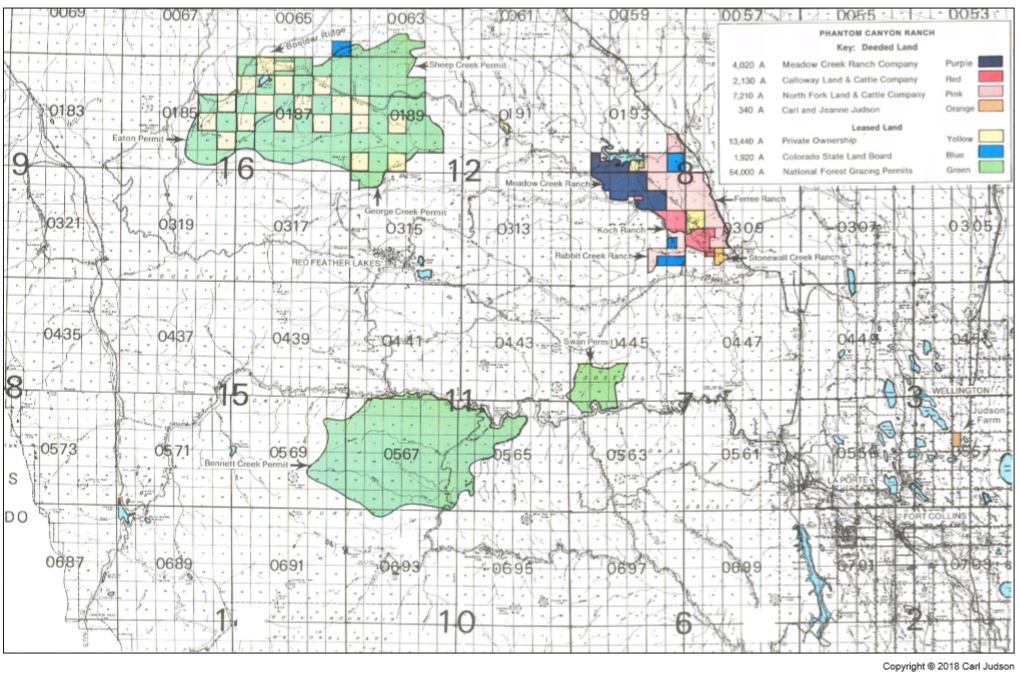Carl Judson, a longtime rancher and resident of Phantom Canyon Ranch, is writing a series on the history of the Phantom Canyon ranch. It is written in short chapters in serial form and distributed periodically by email. The chapters are archived on this site and new ones will be added as they are written.
Click here to explore the history of Phantom Canyon Ranch.
Introduction
copyright © 2018 Carl Judson
Greetings,
Over the last twenty-five years, I have frequently been urged to write a history of Phantom Canyon Ranch. Putting the undertaking off, I half-jokingly offered the excuse that I was waiting for a few funerals and various statutes of limitation to expire.
But, the time has come. This is an invitation to participate in assembling that history. Before it is done, I want to satisfy any questions those who have an interest in the project would like answered.
I’ll welcome queries, comments, corrections and suggestions and will endeavor to address them in future installments and, ultimately, in a final draft that I hope to be suitable for limited publication. My youngest daughter, Nina (an Adobe crackerjack) has agreed to handle the layout, graphics, maps, and photographs.
I intend to write short chapters in serial form and distribute them periodically in the form of PDFs by email to those of you who continue to express an interest in receiving them. If you know someone else who might be interested in being on the list, please don’t hesitate to have them get in touch with me.
REMEMBERING PHANTOM CANYON
While I intend to record the events surrounding Phantom Canyon Ranch and my involvement with reasonable accuracy, around the edges, the story likely will be seasoned with the spice of local lore, the accuracy of which I don’t necessarily intend to vouch for and so may relay as I heard it rather than poking too deeply. If in consequence, anyone living or dead is offended, my apologies in advance.
I want to place Phantom Canyon in the continuum of Livermore and the West. There will be an agricultural center of gravity, because that’s my background. Familiarity with ranching and farming is not as common as it once was, so I’m going to devote some ink to it. And, I’ll want to explain how my ex-wife, Jeanne, and I got involved and were blockheaded enough to see it through. I don’t anticipate that this process will be entirely linear – or brief.
I was born in the Fort Collins hospital more than seventy years ago, grew up working on my father’s farm south of Wellington and have lived all my life (with a few brief exceptions) in Larimer County – more than forty years in Livermore, for which I confess an outsized attachment.
I remember a good bit and have forgotten a bunch. Fortunately, I have a substantial archive to fortify my memory.
Abstract: By the time I graduated from high school, I thought I would never go back to the farm and ended up starting a manufacturing venture that proved successful. That could have been the end of the story.
However, the gravitational pull of agriculture was surprisingly strong, and by 1980 Jeanne and I found ourselves running an integrated farm and ranch operation extending from our Wellington farm, where we grew hay and corn for winter feed, to the top of Boulder Ridge, where we ran cattle in the summer.
We lived halfway between, in the Livermore Valley where Stonewall Creek joins the North Fork of the Cache la Poudre River.
From early June to late September, we only shut down our hay equipment for rain or repairs, putting up three cuttings of alfalfa hay at our Wellington farm (plus custom baling and stacking of hay and straw for neighbors), interspersed with two cuttings of grass hay at the ranch in Livermore.
We had a beautiful old house in a storybook location. Our kids were in a great little country school. We were happy as clams.
Then one day a neighboring rancher, Pat Ferree1, called…
Before we emerged from that rabbit hole, the Phantom Canyon Ranch project was a contiguous assemblage of seven properties with nine dwellings and seventeen miles of river and streams, totaling over 13,000 deeded acres. In addition, the ranch leased about 79,000 acres of private, Union Pacific, State of Colorado and National Forest lands – over 140 square miles in all2. More than 800 acres of hay meadows were irrigated with 77.5 shares of North Poudre Irrigation Company stock delivered through six headgates on the North Poudre Canal, and 37.8 cubic feet per second of direct flow rights from seven diversions on three streams, plus 69 acre feet in four ponds.
Phantom Canyon Ranch has come to be seen as an unusual effort in private land preservation – one that has seasoned with reasonable grace in the thirty years since the original protections were put in place.
While the project was conceived more from the heart than the head and “fire, ready, aim” pretty much sums up how it started, it was a reasonable business undertaking, for which Jeanne and I were joined by more than sixty partners.
From the beginning, a principal objective of the project was land preservation, and to a considerable extent that objective was achieved, but it was a real cliffhanger.
“No silent movie heroine was ever rescued from impending doom after passing through greater perils, following more suspense, with less time to spare, than was Phantom Canyon.”
Jim Reidhead
